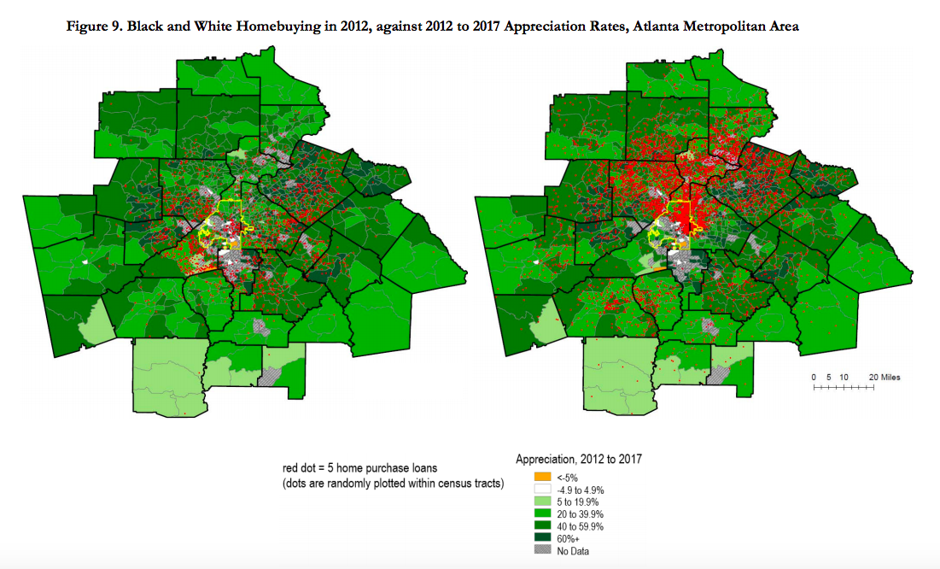The devaluation of assets in black neighborhoods
What does devaluation measure?
We focus on owner-occupied homes for two reasons. First, home appreciation results in higher home values, and this brings wealth to owners. There is a large and well-known wealth gap between blacks and other racial groups in the United States, much of which can be attributed to differences in homeownership rates and the value of housing. Second, the devaluation of rental properties is advantageous to renters, in so far as it results in a lower rental payment for similar quality housing. The devaluation of owner-occupied housing makes it easier to acquire the home, but once purchased, it is unambiguously disadvantageous to the owner and occupier, who would otherwise benefit from being able to refinance, borrow, or sell at a higher valuation.
Absolute difference in home valueis measured as the difference in median home values between neighborhoods with at least 50% black population and neighborhoods that are less than 1% black, using self-reported home values from the American Community Survey. The devaluation analysis also analyzes median listing prices of homes overall and per square foot, using data from Zillow.
Structural characteristics are physical qualities of a home which predict its value, such as year built, square footage, number of rooms/bedrooms, and others (see text for full accounting of variables used). With the exception of square footage, which is incorporated into price per square foot measures used from Zillow, these data are aggregated to the neighborhood level in the analysis.
Neighborhood amenities are qualities which reflect the economic, demographic, and physical landscape of the neighborhood. Indicators which may affect home valuation include the quality of public education, walkability, access to jobs as measured by mean commute times, access to retail, and others (see text for full accounting of variables used).
Devaluation is defined as the percent discount in median home values between neighborhoods with 50% black population and neighborhoods with no black residents, after accounting for structural characteristics of homes and neighborhood amenities. In our preferred estimate, it is calculated by observing the relationship between median neighborhood home prices per square foot (from Zillow) and black population shares across the full range of neighborhoods within individual metropolitan areas that have at least one majority black neighborhood and at least one neighborhood with less than 1% black population shares. In most, though not all, metropolitan areas with at least one neighborhood of each type, the percent difference is negative. Structural characteristics of homes and neighborhood amenities do not fully explain the absolute difference in home value.
--------------
highly recommend y'all check this out
Example:
Atlanta-Sandy Springs-Roswell, GA
Summary metrics:
Median home value in majority black neighborhoods
$139,560
Estimated median home value in majority black neighborhoods, in absence of devaluation
$187,987
Average devaluation of homes in majority black neighborhoods
-29.8%
Black share of metro area population
33.5%
What does devaluation measure?
We focus on owner-occupied homes for two reasons. First, home appreciation results in higher home values, and this brings wealth to owners. There is a large and well-known wealth gap between blacks and other racial groups in the United States, much of which can be attributed to differences in homeownership rates and the value of housing. Second, the devaluation of rental properties is advantageous to renters, in so far as it results in a lower rental payment for similar quality housing. The devaluation of owner-occupied housing makes it easier to acquire the home, but once purchased, it is unambiguously disadvantageous to the owner and occupier, who would otherwise benefit from being able to refinance, borrow, or sell at a higher valuation.
Absolute difference in home valueis measured as the difference in median home values between neighborhoods with at least 50% black population and neighborhoods that are less than 1% black, using self-reported home values from the American Community Survey. The devaluation analysis also analyzes median listing prices of homes overall and per square foot, using data from Zillow.
Structural characteristics are physical qualities of a home which predict its value, such as year built, square footage, number of rooms/bedrooms, and others (see text for full accounting of variables used). With the exception of square footage, which is incorporated into price per square foot measures used from Zillow, these data are aggregated to the neighborhood level in the analysis.
Neighborhood amenities are qualities which reflect the economic, demographic, and physical landscape of the neighborhood. Indicators which may affect home valuation include the quality of public education, walkability, access to jobs as measured by mean commute times, access to retail, and others (see text for full accounting of variables used).
Devaluation is defined as the percent discount in median home values between neighborhoods with 50% black population and neighborhoods with no black residents, after accounting for structural characteristics of homes and neighborhood amenities. In our preferred estimate, it is calculated by observing the relationship between median neighborhood home prices per square foot (from Zillow) and black population shares across the full range of neighborhoods within individual metropolitan areas that have at least one majority black neighborhood and at least one neighborhood with less than 1% black population shares. In most, though not all, metropolitan areas with at least one neighborhood of each type, the percent difference is negative. Structural characteristics of homes and neighborhood amenities do not fully explain the absolute difference in home value.
--------------
highly recommend y'all check this out
Example:
Atlanta-Sandy Springs-Roswell, GA
Summary metrics:
Median home value in majority black neighborhoods
$139,560
Estimated median home value in majority black neighborhoods, in absence of devaluation
$187,987
Average devaluation of homes in majority black neighborhoods
-29.8%
Black share of metro area population
33.5%







